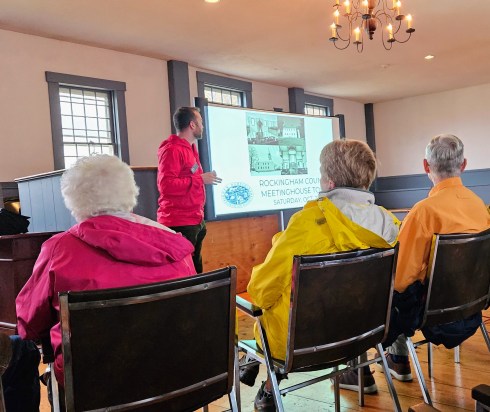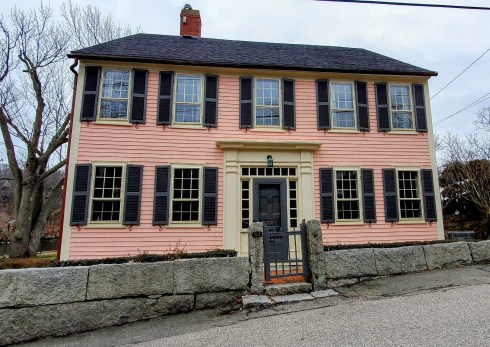Last week was my spring break, and I was determined to get away after spending the past three right here at home during the prolonged Covid Time. I wanted to drive off alone so I could indulge myself with days of endless historic house-spotting: my husband needs a destination and a drink after too much of that! First I planned an extensive trip around revolutionary taverns along much of the east coast, and then I narrowed down my target area to the short-lived colony of New Sweden, incorporating areas of New Jersey, Delaware, and Pennsylvania (and even a bit of Maryland, I think). This trip was further restricted by a delayed departure and the big snowstorm that hit many parts of the northeast: I ended up snowed in at my brother’s house in Rhinebeck, New York. And then I was off, bound for New Castle, Delaware, a small historic city that I had always passed through too quickly. This would be the center of my exploration, but along the way, right before I passed over the Delaware Memorial Bridge, I decided to get off the turnpike and explore Salem County, one of the counties of southern New Jersey that borders Delaware Bay. The sun was shining and it was warm: it seemed as if I had passed from winter into spring, and from the North into the South. I had never been in this region of Jersey, but I had heard about some of its revolutionary history and seen pictures of some of its distinct 18th century houses built of patterned brick, dated and decoratively embellished on one side. I wanted to see one, and I did, and then I wanted to see more: and so I drove down rural roads for hours to do so. Before I knew it, it was dusk, and then I had to drive over that damn bridge in the dark (I have a mild bridge phobia issue and a much stronger tunnel one). New Castle was charming at night and the next morning, when I saw rows of little brick town houses. So forget about any theme of history or function: my spring break (or what was left of it) was just going to be all about little brick houses—and some big brick houses too.







The Dickinson and Oakford Houses, Alloway Township, Salem County New Jersey; the collage is all New Castle houses, with the exception of the conjoined houses in the center–which are in Salem TOWN, New Jersey (more about this other Salem below); New Castle’s old library; this 18th century map shows my travels–on both sides of the Delaware.
Established in 1651 by the Dutch, New Castle was at the center of shifting colonial sovereignties in the middle of the seventeenth century: it became part of a the short-lived colony of New Sweden in 1654, but was recaptured by the Dutch within the year, and in 1680 it was included in the land grant of William Penn, along with the rest of Delaware. New Castle was the capital of the Delaware colony until the Revolution, but before and after it was a center of trade and transportation due to its strategic location on the river. Its pre-revolutionary and pre-industrial wealth created a beautiful city that survives today relatively intact. I don’t really agree with its chamber-of-commerce description: thanks to preservation efforts, this vibrant, fully occupied community remains one of the most important Colonial/Federal villages in America—second only to Williamsburg, Virginia in the number and authenticiy of its historic structures. Williamsburg is a creation, an open-air museum: New Castle is a living city. Though they both have that fixed-in-time feeling, I saw the residents walking around engaged in all sorts of tasks as I walked the streets of New Castle, and they weren’t in colonial costume, like the “residents” of Williamsburg. New Castle is real, but almost too perfect: perfectly-preserved buildings, perfect signage, perfectly laid and -maintained brick sidewalks (it’s like an opposite-word of Salem: they seem to be letting their asphalt sidewalks languish as they replace with brick!), no litter in sight. And while late colonial and federal houses rule, they come in different sizes and were built with different materials: rows of modest brick and wooden houses were just as perfectly maintained as more stately structures. And there are new houses too, built with an obvious mandate to integrate with the old.













Just perfect New Castle, on a perfect day! These are all residences: I’m going to show the museums in my next post. The last two photos show a new house rising on the Strand, and the very old Anglican/Episcopalian Church, Immanuel on the Green, the parish of which has been operating continuously since 1689.
I spent a couple of days in New Castle and then drove lightly northeast into the Brandywine Valley, ostensibly to do some research at the Winterthur library, but I spent more time in the museum and (you guess it) driving around looking for little stone houses. And on my way back home, I turned off the bridge right after I crossed into Jersey rather than before I crossed into Delawar: I wanted to go back to Salem County to hunt for more houses and see the city of Salem as well: I had driven through it days before but didn’t stop. It’s somewhat blighted, with boarded up houses on the main street, but other houses were perfectly restored: it seemed to have quite a bit of integrity and potential. Of course, this Salem has a historical society, and a completely over-the-top but unfortunately former city hall: I wonder what will become of it?



Salem, New Jersey: historical society, murals, and the “exuberant Queen Anne” former municipal building.
One last stop in old New Jersey and then I turned northward. Most of the patterned brick houses are in private hands and hard to find, but one has been turned into a state park: the Hancock House, in Alloway Township, or more particularly a little village within called Hancock’s Bridge. On this very day in 1778, raiding British rangers under the command of Major John Simcoe raided the house and bayoneted as many people as they could find inside: at the very least ten Patriot milita men and also the owner of the house, Judge William Hancock, who was a Loyalist and also, as a Quaker, a pacifist. This became known as the Massacre at Hancock’s Bridge, and just as I was arriving at the house on Saturday morning regiments of reenactors were as well, for the annual commemoration of the massacre. I couldn’t stay around, unfortunately, but I have borrowed a photograph from the HM 17th Regiment of Infantry in America’s facebook page, below. Then I drove home to Massachusetts, making just one stop along the way: at Guilford, Connecticut to see another very old stone house, the 1639 Henry Whitefield House.




Above: The Hancock House, 1734 and members of the HM 17th Regiment of Infantry in America, 1775-1784 on Saturday. Just two streets over, the Quaker Meeting House, built on land donated to the community by Judge Hancock, who was slain on March 21, 1778.
Below: Bonus round. Two little stone houses in Pennsylvania and Connecticut: the John Chads House in Chadds Ford, and the Whitefield House in Guilford.


Like this:
Like Loading...





































































 Along Concord Street, West Gloucester.
Along Concord Street, West Gloucester.




 Along Middle Street, Gloucester.
Along Middle Street, Gloucester.






 Eighteenth-century houses in the Lanesville (ORANGE!) and Annisquam villages of Gloucester, and the Edward Harraden House, c. 1660.
Eighteenth-century houses in the Lanesville (ORANGE!) and Annisquam villages of Gloucester, and the Edward Harraden House, c. 1660.


